Melaleuca pancheri is a shrub or small tree in the myrtle family, Myrtaceae and is endemic to the south of Grande Terre, the main island of New Caledonia. It is one of only a few members of its genus to occur outside Australia and was formerly known as Callistemon pancheri Brongn. & Gris.
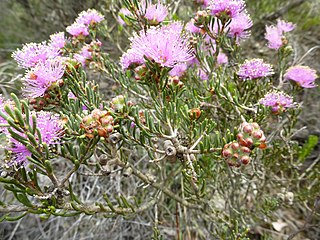
Melaleuca carrii is a plant in the myrtle family, Myrtaceae and is endemic to the south-west of Western Australia. It is a small shrub similar to Melaleuca pentagona, with "pom-pom" heads of pinkish flowers and sharply pointed leaves but it is generally smaller, lacks a groove in its leaves and retains its petals on the flowers for longer than that species.
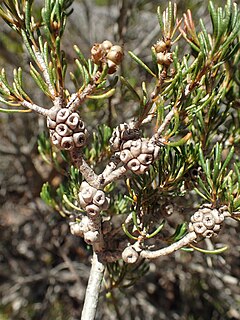
Melaleuca clavifolia is a plant in the myrtle family, Myrtaceae and is endemic to the south-west of Western Australia. It is a small shrub similar to Melaleuca tinkeri, with "pom-pom" heads of pinkish flowers and soft, silky hairs on the new growth but it has larger flower heads and its leaves are shorter, more club-shaped and have less distinct oil glands.
Melaleuca keigheryi is a shrub in the myrtle family, Myrtaceae with white, papery bark and is endemic to the west coast of Western Australia. In spring, it has heads of pink flowers which fade in color to become white.

Melaleuca zonalis is a shrub in the myrtle family Myrtaceae and is endemic to the south-west of Western Australia. It is a shrub with several stems, mostly spoon-shaped leaves and usually pale yellow flowers which age to pink. Whilst it is common, it is restricted to a relatively small area.

Melaleuca thymifolia, commonly known as thyme honey-myrtle, is a plant in the myrtle family Myrtaceae and is native to eastern Australia. It is often noticed in spring, with its attractive, purple flowers and is one of the most commonly cultivated melaleucas. A fragrant shrub, it usually grows to about 1.0 m (3 ft) tall, has corky bark and slender, wiry stems.
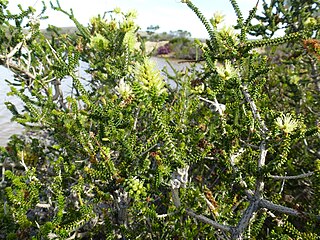
Melaleuca blaeriifolia is an erect to spreading shrub in the myrtle family, Myrtaceae and is endemic to a small area in the south-west of Western Australia. It has small leaves and small greenish-yellow flowerheads.
Melaleuca brevisepala is a shrub in the myrtle family, Myrtaceae and is endemic to the north-west of Grande Terre, the main island of New Caledonia where it is known from only a few locations. It is one of only a few members of its genus to occur outside Australia.
Melaleuca buseana is a shrub or small tree in the myrtle family, Myrtaceae, and is endemic to the south of Grande Terre, the main island of New Caledonia. It is one of only a few members of its genus to occur outside Australia and was formerly known as Callistemon buseanus.

Melaleuca concinna is a small shrub in the myrtle family Myrtaceae and is endemic to the south-west of Western Australia. Its species name translates as " neat" or "pretty" and it is distinguished by having many heads of pink flowers in late spring followed by spherical clusters of woody fruits.
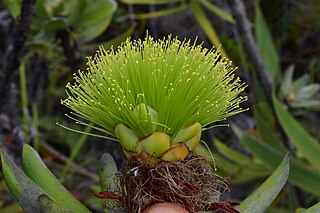
Melaleuca dawsonii is a shrub in the myrtle family, Myrtaceae and is endemic to the south of Grande Terre, the main island of New Caledonia. It is one of only a few members of its genus to occur outside Australia and was formerly known as Callistemon suberosum Pancher ex Brongn. & Gris.

Melaleuca dichroma is a shrub in the myrtle family, Myrtaceae and is endemic to the south-west of Western Australia. It is unusual for its genus in that its flowers are yellow or creamy-white but age to a pinkish-red.

Melaleuca parviceps, commonly known as rough honey-myrtle is a shrub in the myrtle family, Myrtaceae, and is endemic to the south-west of Western Australia. It is a shrub with varying shades of pink or purple flowers, the stamens tipped with yellow anthers. In describing it, John Lindley noted: "every twig ... is terminated by hemispherical heads of brilliant pink". It is similar to Melaleuca manglesii and Melaleuca seriata.

Melaleuca plumea is a shrub in the myrtle family, Myrtaceae, and is endemic to the south of Western Australia. It is a widely spreading, densely foliaged shrub which produces masses of deep pink flowers in spring and early summer. Fluffy hairs on parts of the flowers, including the bracts covering the flower buds, are also a feature.
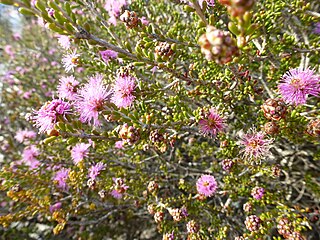
Melaleuca rigidifolia is a shrub in the myrtle family Myrtaceae, endemic to the south of Western Australia. It is similar to Melaleuca plumea with its pink or purple flowers but is distinguished from that species by its lack of fluffy hairs on the flowers and its spherical clusters of fruits.

Melaleuca scabra, commonly known as rough honey-myrtle, is a species of shrub that is endemic to a small area on the south coast of Western Australia. It has warty leaves and profuse, pink to purple heads of flowers between July and November.
Melaleuca sphaerodendra is a plant in the myrtle family Myrtaceae, and is endemic to Grande Terre, the main island of New Caledonia. It is one of only a few members of its genus to occur outside Australia and was previously known as Callistemon gnidioides Guillaumin.
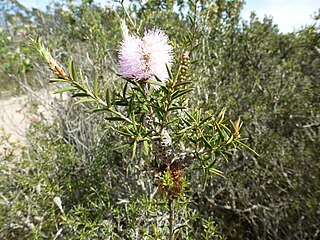
Melaleuca striata is a plant in the myrtle family, Myrtaceae, and is endemic to the south of Western Australia. It has distinctive leaves and heads of pink to mauve flowers, usually in late summer.
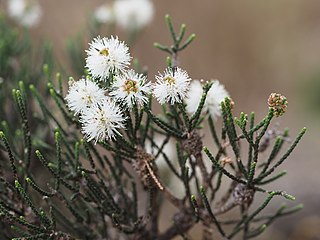
Melaleuca thyoides, commonly known as salt lake honey-myrtle is a plant in the myrtle family, Myrtaceae and is endemic to the south-west of Western Australia. It is an erect shrub with grey, papery or fibrous bark and very small, overlapping leaves on thin branchlets. It is a salt tolerant species often found on the edges of salt lakes.
Melaleuca brongniartii is a shrub in the myrtle family, Myrtaceae and is endemic to the south of Grande Terre, the main island of New Caledonia. It is one of only a few members of its genus to occur outside Australia.













